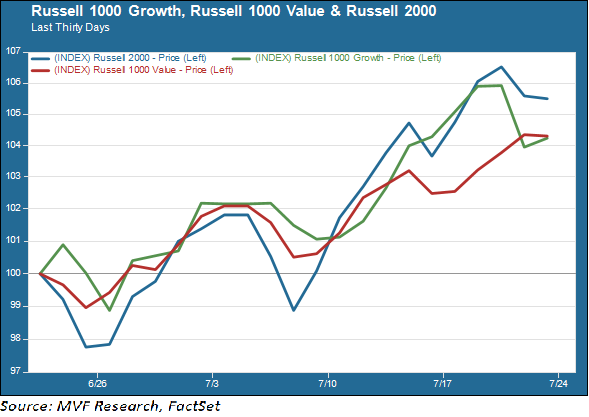
There are many currents afoot in equity markets these days, and not all of them are moving in the same direction. We noted in one of our recent commentaries that the very narrow leadership of a small number of mega cap tech stocks seemed to be broadening out to other corners of the market. It’s a good time to revisit this idea, partly because earnings reports for those Big Tech names are starting to come out, and partly because it remains unclear what alternative themes (if any) might replace the “Magnificent Seven” narrative that drove the lion’s share of those double-digit gains US stock indexes have been enjoying.
Below the Headlines
Earnings season can be confusing for those who pay only cursory attention to the financial news. Take yesterday, for example. Electric vehicle behemoth Tesla reported earnings per share growth of a smidge more than twenty percent from the second quarter of 2022 to the second quarter of 2023. That number was also twelve percent higher than the consensus estimate of analysts who follow the company. Pretty good, right? Double-digit growth plus an upside surprise as the cherry on top. Someone reading the morning headlines might thus have been surprised that, at the end of the day, Tesla shares were down ten percent, one of several names dragging tech-heavy indexes like the Nasdaq sharply lower for the day.
Below the headlines is where the real action takes place, of course. The wet blanket for Tesla was a worse than expected decline in the company’s gross margin, which has come down significantly over the past year due largely to price cuts aimed at stimulating consumer demand. Over at Netflix, another one of yesterday’s big losers, the fly in the milkshake was forward guidance suggesting that average revenue per user (ARPU) was likely to continue trending down amid ongoing tumult in the streaming industry.
Valuation Scrutiny
These below-the-headlines numbers matter a great deal, particularly given where valuations currently stand after the heady first six months of the year for these tech stocks. A sky-high level of price-to-earnings, or price-to-sales or any other metric only makes sense if there is a good case to make that the denominator – the earnings or the sales or what have you – will continue to deliver. Tesla’s current forward (next twelve months) P/E ratio of 63, while fairly modest when compared the extreme-nosebleed levels of 2021, is 3.2 times the NTM P/E for the S&P 500 as a whole. The other growth engines of late – Microsoft, Apple, Nvidia and Netflix to name a few – are also considerably more richly valued than the broader market. And they all will be reporting their sales and earnings in the coming weeks.
Is the Rotation for Real?
That brings us to the question of whether the recent rotation away from Big Tech to other corners of the market is for real. There is still a wide gulf between the growth leaders of 2023 thus far and the also rans. The Russell 1000 Growth index is up around 31 percent for the year to date, while the Russell 1000 Value trails far behind with a gain of just 6.5 percent or so. For the past month, though, both large cap value and small caps generally have outperformed, if only slightly, the growth engines, as shown in the chart below.

One month is not much to go on, and even a modest snapback by growth shares from yesterday’s plunge could change the positioning yet again. And there really is not a single coherent theme to define the value-plus-small caps trend, in the same way that “all things AI” has been the rallying cry for the likes of Microsoft and Nvidia this year.
However, there is a broader macroeconomic narrative that could boost some of the usual residents of value indexes like cyclical industrials and financial institutions. The much-hoped for “soft landing” for the economy as the Fed nears the end of its tightening cycle may actually be at hand. The latest numbers across a range of measures from the jobs market to inflation, consumer confidence and retails sales mostly point to a still-healthy economy. We will get the Q2 GDP numbers next week (along with what is likely to be another 0.25 percent rate hike when the FOMC meets). If we do manage to steer clear of the shoals of recession, though, that could provide more staying power to the equity rotation and offset any retreat from those very expensive tech names.